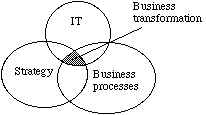
|
|
[top]
In the paper are given fundamental support to high level structuring and modelling of the building process. The concept of a knowledge node is explained and demonstrated in ongoing research projects together with industry. The enabling technologies accounted for are rich user interfaces in the form of multimedia, the World Wide Web, relational databases, and object-oriented languages as Java. The main conclusions from research projects combining a holistic visionary approach and practical implementations are that the described knowledge nodes with underlying general models act well as both distributed knowledge containers and knowledge communication tools both during the design of the node itself and its later targeted use.
[top]
The building industry as well as other parts of social life is facing a gigantic paradigm shift. This shift is characterized by the improvement of the art of communication following the art of writing (2500 b.c.) and the art of printing (1400 a.c.). The ongoing change process is best managed by the industry and academia together. Information Technology, IT, is used both in the readymade systems we develop but also in the actual process of the design and development of them. We must together climb a ladder of maturation which can be characterized as;
A team of persons are involved in the design and building of knowledge nodes. Besides participants from the application areas (Building Research Council, SKANSKA Contractor, Manufacturing and Food industry, Lund University etc.) KBS-Media Lab researchers with different specialties participate; Uno Engborg database design and system level programming, Fredrik Stjernfeldt user modelling, interface and artistic design, World Wide Web programming and initially Johan Bergquist icon design and the author conceptual design, modelling, and implementation.
[top]
There are some important issues we must try to concretize for an efficient management of the change process caused by IT-tools incorporation;
Today we are assembling complex systems with high demands on the competencies of involved people. The systems are to a much lesser degree than before dependent on material manufacturing processes than software engineering. In the Oracle Report nr 1, 1996 we find figure 1 as a practical example and consequence of the ongoing paradigm shift and new business strategies.

|
|
[top]
In the so called Dynamic Knowledge Net (Christiansson, 1993) persons and computer stored knowledge is dynamically connected in ever changing patterns. Groups of peoples can meet other groups in different electronic meeting rooms divided by wall screens. Medical doctors can examine an ear of a patient at another hospital where no specialists are available. At the same time the student doctors effectively learn new skills by virtually participating in a telepresence medical ear examination.
A more consistent computer storedknowledge mass will gradually develop on a global scale, where artificial constraints which today may stop knowledge communication (e.g. due to the absence of proper books and poor information infrastructures) will degrade. In the same way as material production has been and will continue to be more efficient the same thing will happen in the evolving knowledge industry. That is we will get more free time. In the good scenario this liberation of human resources will lead to several things
[top]
The emerging knowledge industry possesses some new properties due to the growing number of globally connected computers. The border between sellable and free (paid through common fees as taxes) will be shifted. New exclusive knowledge items will be retailed, filtered, and packaged for a wider audience than today. The knowledge stored in persons head will though be as valuable as today. Knowledge about how we learn to learn will be even more important to package when schools and universities get more virtual and suited for space independent personal life long learning.
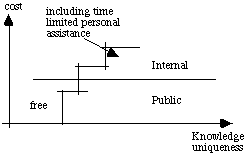
|
|
We will see more of the type of service that the Networked Computer Science Technical Reports Library, NCSTRL, offers. This "is an international collection of computer science technical reports from CS departments and industrial and government research laboratories, made available for non-commercial and educational use. The NCSTRL collection is distributed among a set of interoperating servers operated by participating institutions." (NCSTRL, 1996).
Other type of products will be knowledge packages in the form of objects containing e.g. user models templates or search agents.
[top]
A Knowledge Node is not an expression that you find in Merriam Webster's dictionary. It is merely a collective term for a new artifact that we are designing. A knowledge node with our definition is a virtual artifact which
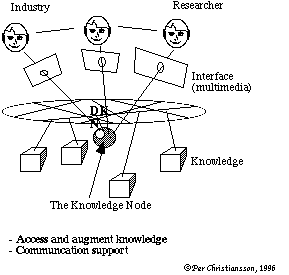
|
|
The Oracle Corp. has a Corporate Repository which is a kind of company knowledge node. This a container for all sorts of product and company information. The information is stored in different formats and can be reached via the WWW in an Intranet solution.
The access restrictions to a knowledge node are dependent on (se also figure 8)
[top]
During the design and development phase of the SWEBU Knowledge Node, Swedish Building Research on the World Wide Web, the system gradually evolves in participation with the users. A special Working Area (Arbetsyta) is designated to support collaboration over the Word Wide Web. This area will after the system is put in use be transformed to a maintenance area .
The Working Area, WA, is always accessible from any WWW-client (providing you are project participant). It has three different sub areas, se figure 5.
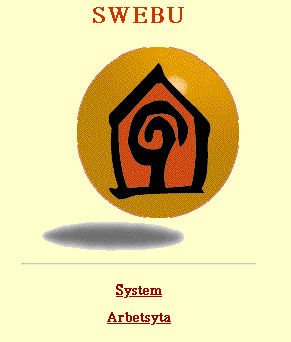
|
|
The Meeting Notes are updated directly after a scheduled project group meeting and contains meeting notes and figures. In this way each project participant can independent of computer platform, space and time access the meeting notes.
The Note Board is used to make propositions available for comments at any time point. It is has often been used in different projects to put forward design proposals e.g. alternative user interfaces and data models (tables in a relational database). An FTP image transfer service is also available here.
Clicking at the Communication icon (the semaphoring person) activates a communication window where you can choose between personal or group email, get information about project participants, and how to connect to the video conference server and even establish a group telephone call.
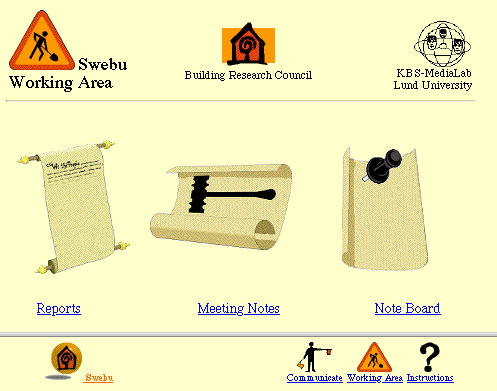
|
|
[top]
As we leave the small scale domain (sometimes referred to as the toy problem domain) and scale up a single-user rather isolated system we run into different problems, see figure 6.
In addition to the overview in figure 6 we also meet other problems to tackle; simultaneous user access to distributed knowledge, hardware platform dependencies, knowledge domain concurrences, security issues, knowledge ownership, and integration of knowledge representations.
Our own experiences going from one user systems with multimedia interfaces to underlying facts bases are positive. We can use the 1st generation of the DKN namely the World Wide Web to house the same functionality as in the one user systems. Some of the more important findings are
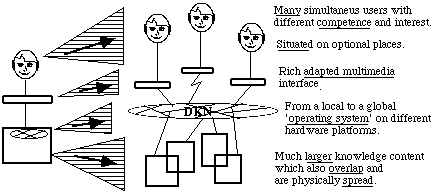
|
|
[top]
The demonstrator method (incremental prototyping) supports the development of system interfaces and knowledge structures which support specific application areas. This is a very important fact and often disregarded in conventional system development where a requirements list/specification is handed over to the system developers (and eventually carefully studied). Now a continuos evaluation and appraisal can be properly done
During new IT-tools and artifacts development it will be very hard to grasp ideas put forward if they are not visualized and exemplified in a demonstrator environment together with the end users of the systems (continuos appraisal). We use the demonstrator concept to capture, communicate, evaluate and implement new (creative) ideas continuously in a dialectic process with the end users of the system.
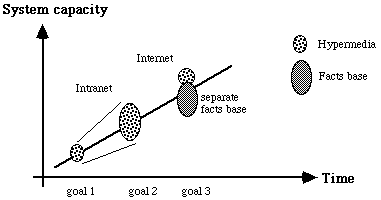
|
|
[top]
During the design of a knowledge node adequate models have to be defined on high abstraction levels to provide a skeleton for understanding, discussion of and linkage to other systems.
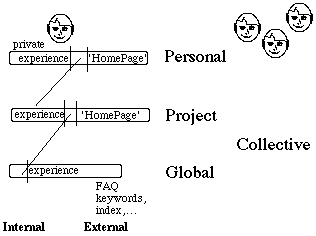
|
|
[top]
For the free text search mechanisms we use a standard index search machine from Excite (http://www.excsite.com). More similar packages are available e.g. Personal-, Village- or Intranet- Altavista (http://www.altavista.digital.com) and also automatic personal WWW-index making agents from Hitachi Corp (http://www.zoosoft.com/zooworks/) .
The knowledge augmentation and storage are done near the sources by security and administrative reasons. Guide lines are available for how knowledge shall be locally stored (as HTML, database tables, applets, etc.) to be searchable through the knowledge node. A vocabulary is attached and incremented to minimize semantic ambiguity when communicating with the knowledge base.
The hardware platform used is SUN Sparc for the bigger systems and also Apple Macintosh for initial system design.
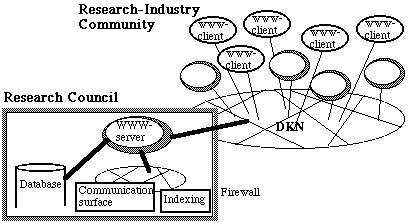
|
|
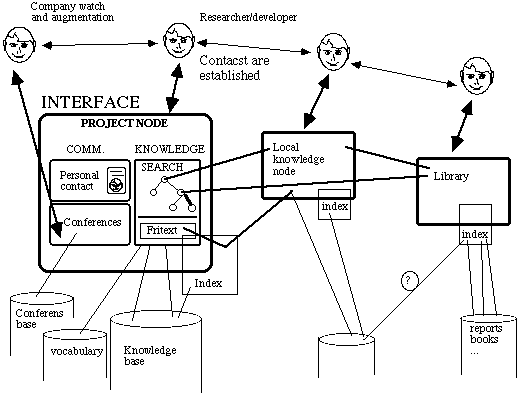
|
|
[top]
The users are classified according to their work tasks and responsibilities. We also introduced the level of user experience and interest in the selected domain when we build a personal agent to help the user search and navigate the Internet, (Lagerstedt, et.al., 1996). This agent has a long term (neural net) and a short term (rule based) memory.
The interest for how intelligent agents can be designed is growing. Newly an international organization has been founded which aims at structuring and standardizing modules to build intelligent systems, FIPA, Foundation Intelligent Physical Agents.
[top]
The computer stored context model influences our expectations when we use the knowledge node. It makes a task seem easy or difficult, enjoyable, challenging etc. We associate and compare with in our brain stored patterns which should somehow be in harmony with the computer stored knowledge and the persons we interact (communicate) with. Virtual Reality, VR, may increase the presence feeling and user participation and new tools will be invented.
The search and navigation process as well as knowledge augmentation and system maintenance has been touched upon above. The user must be helped in the process of getting hints about changed state of interest in the knowledge node. This can be done manually through the communication area or automatically by an agent doing pre evaluation of incoming information according to the users specifications.
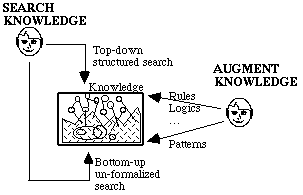
|
|
[top]

|
|
As we construct big global knowledge bases the abstraction hierarchies will be further developed in the DKN as well as the knowledge base learning mechanisms. The work initiated by Douglas Lenat in the Cyc-project (from the word enCYClopedia) follows a top-down approach to formalize knowledge as facts, logical rules, and heuristics for reasoning about the objects and events of everyday life, (Cycorp, 1995). A complementary direction is a more un-formalized and sub-symbolic neural network oriented approach e.g. as in the work on Cog ( a set of sensors and actuators which tries to approximate the sensory and motor dynamics of a human body) lead by Rodney Brooks at AI-Lab MIT, (COG, 1996).
We use a mix of overlapping knowledge representations depending on content and how the knowledge is generated. Imagine also what will happen when we implement thousands of TCP/IP-connections to more or less intelligent artifacts in our homes and work environments (mobile phone, electricity meter, moisture sensors, etc.). The demands on the Dynamic Knowledge Net increases!
The first steps towards a secure object handling in the DKN has been taken with the introduction of Java applets. Though "downloading Java applets over the Internet to a remote client is just as slow as downloading a GIF image; for executables over 30 or 40 kilobytes, it can be painful.", comments from (Jernigan R, 1996). (Rayme R., 1996) talks about a Network centered world versus a desktop centered (with Java applets). The capacity problems are due to infancy of a global operating networked system and will lead to further definition of virtual client computers and secure object handling and storage.
Efforts are underway to define a generic SQL database access framework to control database access via DBMS-independent Java applications, JBDC, Java Database Connectivity, (Hamilton and Cattell, 1996).
Finally the COSMO development should be mentioned which is an amalgamation of HTML, VRML and JAVA. COSMO enables the creation of cross-platform 3D world with interactive multimedia interfaces. According to (Beazley and Chapman, 1996) VRML, Virtual Reality Modeling Language, which is based on the Open Inventor modeling language from Silicon Graphics, already is becoming a de facto standard for transporting 3D models on the World Wide Web. It can be regarded as a 3D version of the HTML. Models can have different levels of detail and be animated
[top]
The paper in its first part puts the work in a long term context followed by more practical issues concerning implementation and experiences. The main conclusions of the work on designing, building, and using knowledge nodes are;
[top]